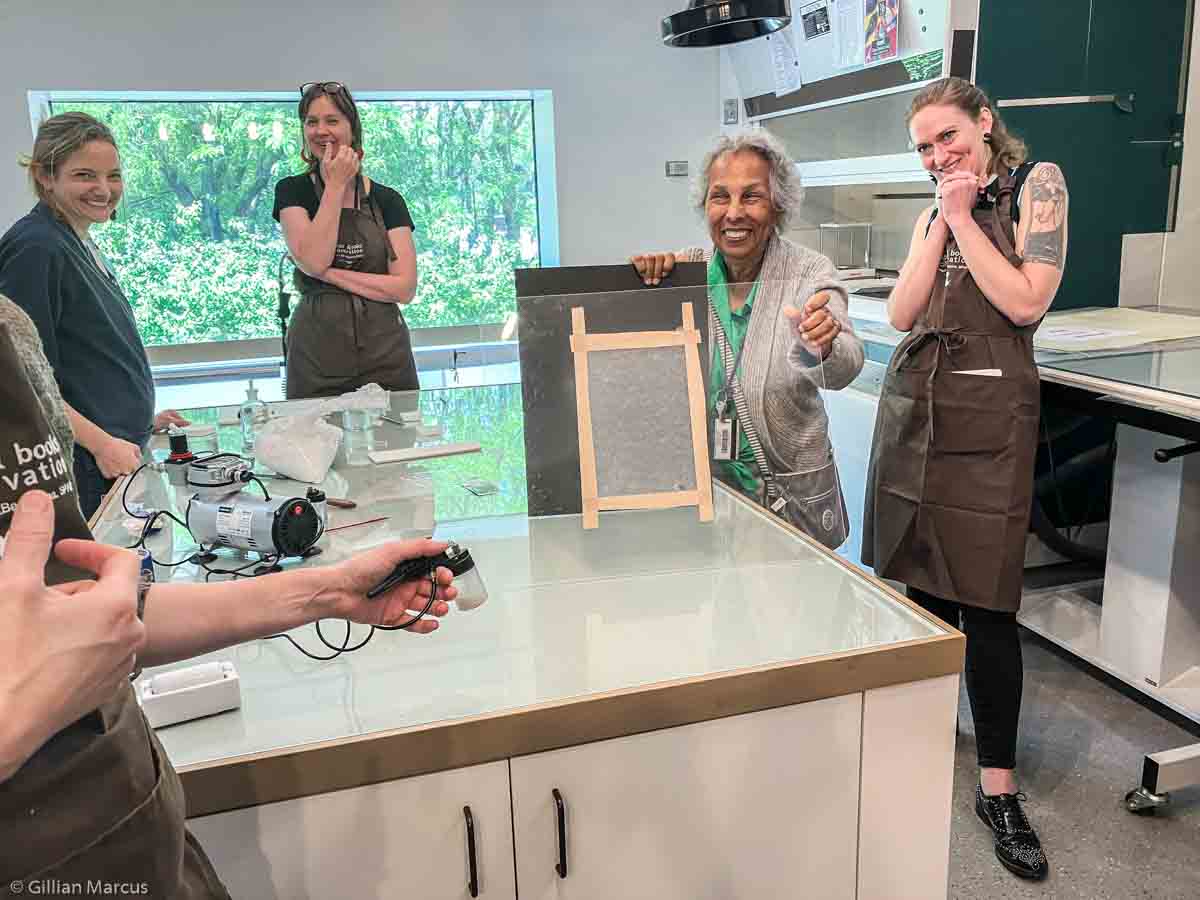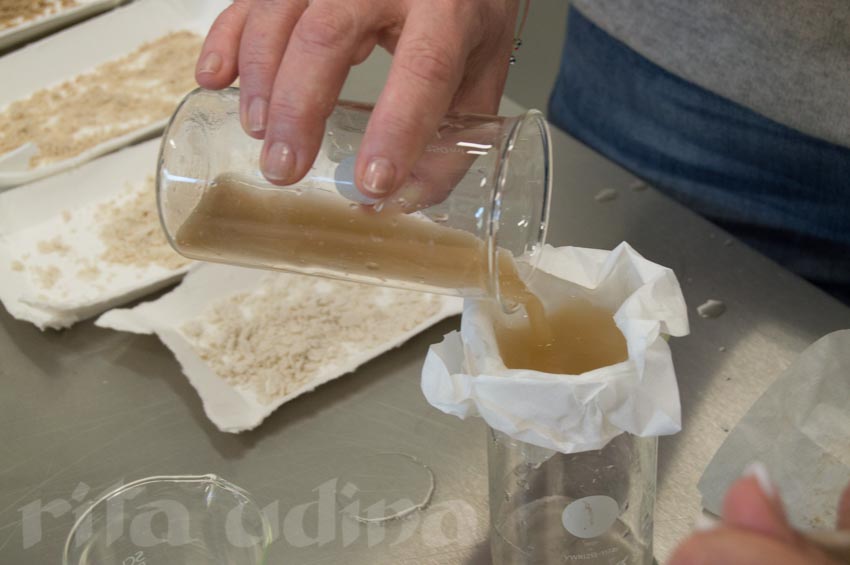Course: Match your infill (London, 2024)
- Course title: Match your infill.
- Project: Course with practical and theoretical sessions (18 hours).
- Teacher: Rita Udina.
- Organization: Arantza Dobbles (Tate Britain, ICON).
- Venue: Tate Britain Paper Conservation studio (London, United Kingdom).
- Language: English.
- Dates: May 22-24th, 2024.
- Fee: £325 ICON members, £400 non members.
- Audience: Book, photograph and paper conservators in practice. There are 8 spots available in this workshop. The workshop will have 16 participants in total, with 8 participants being paper conservators from Tate.
- Registration: Pre-sale tickets for members only will go live on Monday, 4th March, so save the date! Any remaining tickets will go on sale for non-members the following week. Other questions: iconbgp@gmail.com; ICON.
- Contents (theory and practice):
Techniques, materials and products to infill and in-paint.
Mould casting of textures (either acrylic or cellulose powdered based), matching colour with paper pulp, dyes and colorants, colour, digital retouch, tips and tricks for retouching.
-
- Theory and case studies:
- Filling losses and fillers: powdered cellulose, paper pulp, Japanese paper.
- Modifying the appearance and texture of Japanese paper, silicone mould casting to replicate textures.
- Inpainting media and toning systems: synthetic resins, watercolour/gouache, pencils/pastels, dry pigments, dyes, colorants and other colouring agents.
- Light and colour phenomena, metamerism (optional).
- Modifiers: glossing, matting, polishing agents (optional).
- Theory and case studies:
-
- Techniques and criteria for in-painting:
- Chromatic Selection and Chromatic abstraction.
- Rigatino, tratteggio: Fiorentino vs. Romano.
- Underleveled.
- Neutral colour field.
- Mimetic.
- Digital technology.
- Ethical considerations.
- Techniques and criteria for in-painting:
This workshop is being held in collaboration with Tate’s Paper and Photograph Conservation team, and will be held at Tate Britain’s paper conservation studio. Most materials will be provided for, but it is recommended that participants bring their own conservation toolkits (mixing spatulas, scalpels and brushes), aprons and small watercolour sets.

From left to right (standing): Ina Baumeister (Tate), Vivian Yip (Tate), Emily Williams (Tate), Janay Laudat (Tate), Femke Segers (Tate), Sofie Mewes (Foto Museum, Antwerp), Elisabeth Fagg-Shuttlewood (British Library), Victoria Haddock (Conservatoria), Caroline Harrison (Harrison Conservation) and Emma Nichols (Cambridge University).
From left to right (seated): Sophie Sarkodie (Tate), Arantza Dobbels-Busto (Tate), Rita Udina, Samantha Ferrer (Comhairle Nan Eilean Siar), Anne-Marie Miller (Codex Conservation) and Ann Tang (Codex Conservation).
Foto: © Larina Annora Fernandes (Tate).
Other editions:
Clients
Types of projects
Course: Match your infill (London, 2024)
- Course title: Match your infill.
- Project: Course with practical and theoretical sessions (18 hours).
- Teacher: Rita Udina.
- Organization: Arantza Dobbles (Tate Britain, ICON).
- Venue: Tate Britain Paper Conservation studio (London, United Kingdom).
- Language: English.
- Dates: May 22-24th, 2024.
- Fee: £325 ICON members, £400 non members.
- Audience: Book, photograph and paper conservators in practice. There are 8 spots available in this workshop. The workshop will have 16 participants in total, with 8 participants being paper conservators from Tate.
- Registration: Pre-sale tickets for members only will go live on Monday, 4th March, so save the date! Any remaining tickets will go on sale for non-members the following week. Other questions: iconbgp@gmail.com; ICON.
- Contents (theory and practice):
Techniques, materials and products to infill and in-paint.
Mould casting of textures (either acrylic or cellulose powdered based), matching colour with paper pulp, dyes and colorants, colour, digital retouch, tips and tricks for retouching.
-
- Theory and case studies:
- Filling losses and fillers: powdered cellulose, paper pulp, Japanese paper.
- Modifying the appearance and texture of Japanese paper, silicone mould casting to replicate textures.
- Inpainting media and toning systems: synthetic resins, watercolour/gouache, pencils/pastels, dry pigments, dyes, colorants and other colouring agents.
- Light and colour phenomena, metamerism (optional).
- Modifiers: glossing, matting, polishing agents (optional).
- Theory and case studies:
-
- Techniques and criteria for in-painting:
- Chromatic Selection and Chromatic abstraction.
- Rigatino, tratteggio: Fiorentino vs. Romano.
- Underleveled.
- Neutral colour field.
- Mimetic.
- Digital technology.
- Ethical considerations.
- Techniques and criteria for in-painting:
This workshop is being held in collaboration with Tate’s Paper and Photograph Conservation team, and will be held at Tate Britain’s paper conservation studio. Most materials will be provided for, but it is recommended that participants bring their own conservation toolkits (mixing spatulas, scalpels and brushes), aprons and small watercolour sets.

From left to right (standing): Ina Baumeister (Tate), Vivian Yip (Tate), Emily Williams (Tate), Janay Laudat (Tate), Femke Segers (Tate), Sofie Mewes (Foto Museum, Antwerp), Elisabeth Fagg-Shuttlewood (British Library), Victoria Haddock (Conservatoria), Caroline Harrison (Harrison Conservation) and Emma Nichols (Cambridge University).
From left to right (seated): Sophie Sarkodie (Tate), Arantza Dobbels-Busto (Tate), Rita Udina, Samantha Ferrer (Comhairle Nan Eilean Siar), Anne-Marie Miller (Codex Conservation) and Ann Tang (Codex Conservation).
Foto: © Larina Annora Fernandes (Tate).




























